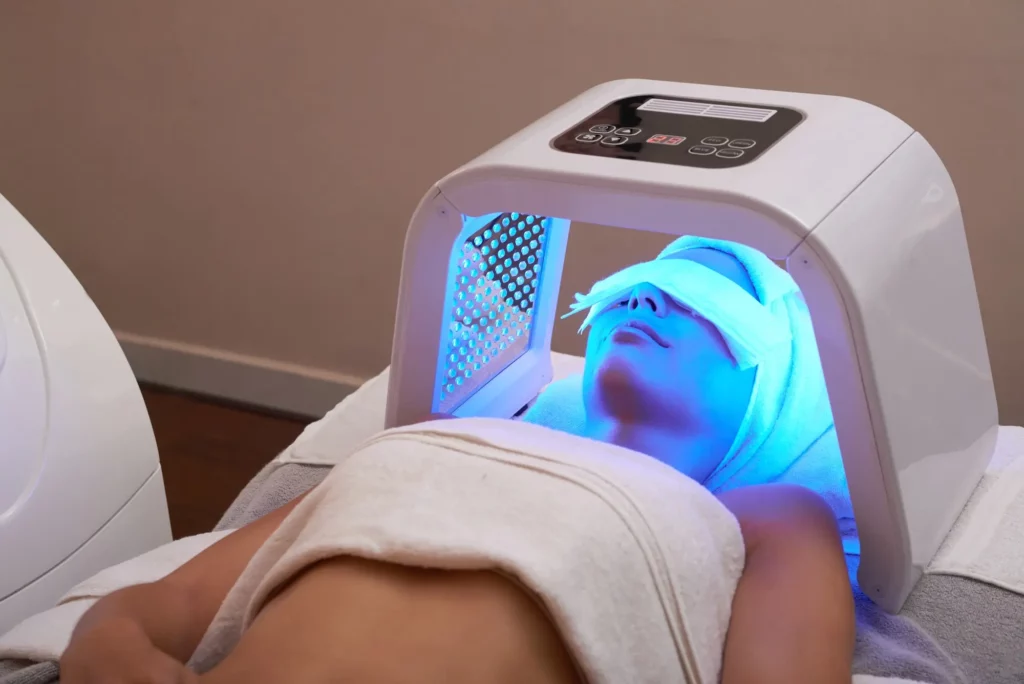Phototherapy, also known as light therapy, has emerged as a significant treatment modality for various skin conditions, including vitiligo and atopic dermatitis. This approach harnesses the power of specific wavelengths of light to manage symptoms, promote healing, and improve skin health. In this article, we’ll delve into how phototherapy works, its effectiveness for vitiligo and atopic dermatitis, and key considerations for those exploring this treatment option.
What Is Phototherapy?
Phototherapy involves the use of ultraviolet (UV) light or other specific wavelengths to treat skin conditions. The therapy targets the skin with controlled doses of light to achieve therapeutic effects, such as reducing inflammation or stimulating pigment production. There are different types of phototherapy, each tailored for specific conditions.
How Does Phototherapy Work?
Phototherapy works by targeting the skin with light at specific wavelengths to achieve therapeutic effects:
- For Vitiligo: NB-UVB light stimulates melanocytes (pigment-producing cells) to repigment the skin. The light therapy triggers the production of new melanocytes and stimulates existing melanocytes to produce melanin.
- For Atopic Dermatitis: Phototherapy reduces inflammation and itching by modulating the immune response and suppressing inflammatory cytokines.
Effectiveness of Phototherapy for Vitiligo
A. Vitiligo and Narrowband UVB Phototherapy
- How It Works: NB-UVB therapy involves exposing the skin to UVB light in a controlled environment. It stimulates melanocytes to produce pigment and helps to restore skin color.
- Effectiveness: Studies show that NB-UVB phototherapy can be highly effective for vitiligo, especially in early stages or with limited areas of affected skin. Research indicates that about 60–80% of patients experience significant repigmentation with regular treatments.
- Treatment Schedule: Typically involves 2–3 sessions per week for 6–12 months.
- Considerations: Results can vary, and treatment is more effective when started early. Maintenance therapy may be required to sustain results.
B. Vitiligo and PUVA Therapy
- How It Works: PUVA therapy combines a photosensitizing agent (psoralen) with UVA light to induce repigmentation.
- Effectiveness: PUVA therapy is effective for vitiligo but less commonly used due to the need for oral medication and potential side effects.
- Treatment Schedule: Involves psoralen administration followed by UVA light exposure 2–3 times a week.
- Considerations: Long-term use can increase the risk of skin cancer and photoaging. Regular monitoring by a dermatologist is necessary.
Effectiveness of Phototherapy for Atopic Dermatitis
A. Atopic Dermatitis and Narrowband UVB Phototherapy
- How It Works: NB-UVB therapy alleviates symptoms by reducing inflammation and itching.
- Effectiveness: Studies show that NB-UVB phototherapy is effective in reducing symptoms of atopic dermatitis, with about 70–80% of patients experiencing improvement.
- Treatment Schedule: Typically 2–3 times a week for several weeks.
- Considerations: Can be used as a primary treatment or in combination with topical therapies.
B. Atopic Dermatitis and PUVA Therapy
- How It Works: Similar to vitiligo treatment, PUVA therapy is less commonly used for atopic dermatitis but can be effective for severe cases.
- Effectiveness: PUVA therapy can improve symptoms, but its use is generally reserved for cases that do not respond to other treatments.
- Treatment Schedule: Typically involves psoralen administration followed by UVA light exposure 2–3 times a week.
- Considerations: As with vitiligo, there is a risk of long-term side effects, including skin aging and cancer.
Practical Considerations for Phototherapy
A. Preparing for Treatment
- Consultation: Always start with a dermatologist to determine if phototherapy is appropriate for your condition.
- Pre-Treatment: You may need to avoid sun exposure and use sunscreen before and after treatment.
B. During Treatment
- Sessions: Be consistent with your treatment schedule to achieve the best results.
- Side Effects: Common side effects include redness, itching, and dryness. Long-term side effects may include an increased risk of skin cancer and skin aging, particularly with PUVA therapy.
C. Post-Treatment Care
- Skin Care: Continue using sunscreen and moisturizers to protect your skin and maintain treatment benefits.
- Monitoring: Regular follow-ups with your dermatologist are essential to assess treatment progress and adjust therapy as needed.
Conclusion
Phototherapy offers an effective treatment option for managing vitiligo and atopic dermatitis, with a range of methods available to suit different needs and conditions. Narrowband UVB phototherapy is the most commonly used and has shown high effectiveness for both vitiligo and atopic dermatitis, providing significant improvements for many patients. PUVA therapy and excimer laser therapy offer additional options but come with specific considerations and potential side effects.
If you are struggling with vitiligo or atopic dermatitis, consulting a dermatologist will help determine if phototherapy is right for you and which type will best meet your needs. With proper management and adherence to treatment plans, phototherapy can be a powerful tool in achieving clearer, healthier skin.





Comments